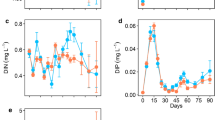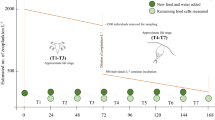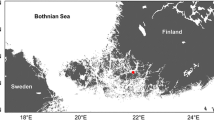Abstract
Concern about climate change has re-ignited interest in universal ecological responses to temperature variations: (1) biogeographical shifts, (2) phenology changes, and (3) size shifts. In this study we used copepods as model organisms to study size responses to temperature because of their central role in the pelagic food web and because of the ontogenetic length constancy between molts, which facilitates the definition of size of distinct developmental stages. In order to test the expected temperature-induced shifts towards smaller body size and lower abundances under warming conditions, a mesocosm experiment using plankton from the Baltic Sea at three temperature levels (ambient, ambient +4 °C, ambient −4 °C) was performed in summer 2010. Overall copepod and copepodit abundances, copepod size at all life stages, and adult copepod size in particular, showed significant temperature effects. As expected, zooplankton peak abundance was lower in warm than in ambient treatments. Copepod size-at-immature stage significantly increased in cold treatments, while adult size significantly decreased in warm treatments.






Similar content being viewed by others
References
Batten SD, Walne AW (2011) Variability in northwards extension of warm water copepods in the NE Pacific. J Plankton Res 33:1643–1653
Beaugrand G, Reid PC, Ibanez F, Lindley JA, Edwards M (2002) Reorganization of North Atlantic marine copepod biodiversity and climate. Science 296:1692–1694
Behrends G (1996) Long-term investigation of seasonal zooplankton dynamics in Kiel Bight, Germany. Proceedings of the 13th Baltic Marine Biology Symposium, Jurmala, Institute of Aquatic Ecology, University of Latvia, Riga, pp 93–99
Bergmann K (1847) Ueber die Verhältnisse der Wärmeökonomie der Thiere zu ihrer Grösse
Blackburn TM, Gaston KJ, Loder N (1999) Geographic gradients in body size: a clarification of Bergmann’s rule. Divers Distrib 5:165–174
Bochdansky AB, Grønkjær P, Herra TP, Leggett WC (2005) Experimental evidence for selection against fish larvae with high metabolic rates in a food limited environment. Mar Biol 147:1413–1417
Boyce DG, Lewis MR, Worm B (2010) Global phytoplankton decline over the past century. Nature 466:591–596
Brown JH, Gillooly JF, Allen AP, Savage VM, West GB (2004) Toward a metabolic theory of ecology. Ecology 85:1771–1789
Campbell RG, Wagner MM, Teegarden GJ, Boudreau CA, Durbin EG (2001) Growth and development rates of the copepod Calanus finmarchicus reared in the laboratory. Mar Ecol Prog Ser 221:161–183
Claireaux G, Lefrancois C (2007) Linking environmental variability and fish performance: integration through the concept of scope for activity. Philos Trans Royal Soc B Biol Sci 362:2031–2041
Cottingham KL, Lennon JT, Brown BL (2005) Knowing when to draw the line: designing more informative ecological experiments. Front Ecol Environ 3:145–152
Daufresne M, Lengfellner K, Sommer U (2009) Global warming benefits the small in aquatic ecosystems. Proc Nat Acad Sci USA 106:12788–12793
Edwards M, Richardson AJ (2004) Impact of climate change on marine pelagic phenology and trophic mismatch. Nature 430:881–884
Escribano R, McLaren IA (1992) Influence of food and temperature on lengths and weights of 2 marine copepods. J Exp Mar Biol Ecol 159:77–88
Forster J, Hirst AG, Atkinson D (2011) How do organisms change size with changing temperature? The importance of reproductive method and ontogenetic timing. Funct Ecol 25:1024–1031
Forster J, Hirst AG, Atkinson D (2012) Warming-induced reductions in body size are greater in aquatic than terrestrial species. Proc Nat Acad Sci USA 109:19310–19314
Gardner JL, Peters A, Kearney MR, Joseph L, Heinsohn R (2011) Declining body size: a third universal response to warming? Trends Ecol Evol 26:285–291
Gaudy R, Verriopoulos G (2004) Spatial and seasonal variations in size, body volume and body proportion (prosome : urosome ratio) of the copepod Acartia tonsa in a semi-closed ecosystem (Berre lagoon, western Mediterranean). Hydrobiologia 513:219–229
Gismervik I, Olsen Y, Vadstein O (2002) Micro- and mesozooplankton response to enhanced nutrient input–a mesocosm study. Hydrobiologia 484:75–87
Goodman RE, Lebuhn G, Seavy NE, Gardali T, Bluso-Demers JD (2012) Avian body size changes and climate change: warming or increasing variability? Glob Change Biol 18:63–73
Hillebrand H, Dürselen CD, Kirschtel D, Pollingher U, Zohary T (1999) Biovolume calculations for pelagic and benthic microalgae. J Phycol 35:403–424
Hirst AG, Kiorboe T (2002) Mortality of marine planktonic copepods: global rates and patterns. Mar Ecol Prog Ser 230:195–209
IPCC (2007) Climate change 2007: the physical science basis. UNEP and WHO, Cambridge
Klein Breteler WCM, Schogt N, Gonzalez SR (1990) On the role of food quality in grazing and development of life stages and genetic change of body size during cultivation of pelagic copepods. J Exp Mar Biol Ecol 135:177–189
Klein Breteler WCM, Schogt N (1994) Development of Acartia clausi (Copepoda, Calanoida) cultured at different conditions of temperature and food. Hydrobiologia 292-293:469–479 LA–English
Kobari T, Ikeda T (2001) Ontogenetic vertical migration and life cycle of Neocalanus plumchrus (Crustacea : Copepoda) in the Oyashio region, with notes on regional variations in body sizes. J Plankton Res 23:287–302
Kordas RL, Harley CDG, O’Connor MI (2011) Community ecology in a warming world: the influence of temperature on interspecific interactions in marine systems. J Exp Mar Biol Ecol 400:218–226
Koski M, Breteler WK, Schogt N (1998) Effect of food quality on rate of growth and development of the pelagic copepod Pseudocalanus elongatus (Copepoda, Calanoida). Mar Ecol Prog Ser 170:169–187
Krueger C, Tian L (2004) A comparison of the general linear mixed model and repeated measures anova using a dataset with multiple missing data points. Biol Res Nurs 6:151–157
Leandro SM, Queiroga H, Rodriguez-Grana L, Tiselius P (2006) Temperature-dependent development and somatic growth in two allopatric populations of Acartia clausi (Copepoda : Calanoida). Mar Ecol Prog Ser 322:189–197
Lewandowska AM, Sommer U (2010) Climate change and the spring bloom: a mesocosm study on the influence of light and temperature on phytoplankton and mesozooplankton. Mar Ecol Prog Ser 405:101–111
Mackas DL et al (2012) Changing zooplankton seasonality in a changing ocean: comparing time series of zooplankton phenology. Prog Oceanogr 97:31–62
Menden-Deuer S, Lessard EJ (2000) Carbon to volume relationships for dinoflagellates, diatoms, and other protist plankton. Limnol Oceanogr 45:569–579
Möllmann C, Kornilovs G, Fetter M, Koster FW (2005) Climate, zooplankton, and pelagic fish growth in the central Baltic Sea. ICES J Mar Sci 62:1270–1280
Möllmann C, Müller-Karulis B, Kornilovs G, St John MA (2008) Effects of climate and overfishing on zooplankton dynamics and ecosystem structure: regime shifts, trophic cascade, and feedback loops in a simple ecosystem. ICES J Mar Sci 65:302–310
Müller H, Geller W (1993) Maximum growth rates of aquatic ciliated protozoa–the dependence on body size and temperature reconsidered. Arch Hydrobiol 126:315–327
O’Connor MI, Piehler MF, Leech DM, Anton A, Bruno JF (2009) Warming and resource availability shift food web structure and metabolism. Plos Biol 7:e1000178
Parmesan C, Yohe G (2003) A globally coherent fingerprint of climate change impacts across natural systems. Nature 421:37–42
Patridge L, Barrie B, Fowler K, French V (1994) Evolution and development of body size and cell size in Drosophila melanogaster in response to temperature. Evolution 48:1269–1276
Pearman PB et al (2008) Prediction of plant species distributions across six millennia. Ecol Lett 11:357–369
Petchey OL, McPhearson PT, Casey TM, Morin PJ (1999) Environmental warming alters food-web structure and ecosystem function. Nature 402:69–72
Putt M, Stoecker DK (1989) An experimentally determined carbon—volume ratio for marine oligotrichous ciliates from estuarine and coastal waters. Limnol Oceanogr 34:1097–1103
Reading CJ (2007) Linking global warming to amphibian declines through its effects on female body condition and survivorship. Oecologia 151:125–131
Shannon CE, Weaver W (1963) Mathematical theory of communication. University Illinois Press, III
Sheridan JA, Bickford D (2011) Shrinking body size as an ecological response to climate change. Nat Clim Change 1:401–406
Sommer U, Lengfellner K (2008) Climate change and the timing, magnitude, and composition of the phytoplankton spring bloom. Glob Change Biol 14:1199–1208
Sommer U, Lewandowska AM (2011) Climate change and the phytoplankton spring bloom: warming and overwintering zooplankton have similar effects on phytoplankton. Glob Change Biol 17:154–162
Sommer U et al (2007) An indoor mesocosm system to study the effect of climate change on the late winter and spring succession of Baltic Sea phyto- and zooplankton. Oecologia 150:655–667
Sweeney BW, Vannote RL, Doods PJ (1986) The relative importance of temperature and diet to larval development and adult size of the winter stonefly, Soyedina carolinensis (Piecoptera: Nemouridae). Freshw Biol 16:39–48
Taucher J, Schulz KG, Dittmar T, Sommer U, Oschlies A, Riebesell U (2012) Enhanced carbon overconsumption in response to increasing temperatures during a mesocosm experiment. Biogeosciences 9:3531–3545
Thresher RE, Koslow JA, Morison AK, Smith DC (2007) Depth-mediated reversal of the effects of climate change on long-term growth rates of exploited marine fish. Proc Natl Acad Sci 104:7461–7465
Utermöhl H (1958) Zur Vervollkommnung der quantitativen Phytoplankton-Methodik. Mitteilungen. Int Vereiningung Theor Angew Limnol 9:1–38
Villegas CT, Kanazawa A (1979) Relationship between diet composition and growth rate of the zoel and mysis stages of Penaeus japonicus Bate. Fish Res J Philipp 4:32–40
Walther GR et al (2002) Ecological responses to recent climate change. Nature 416:389–395
Winder M, Sommer U (2012) Phytoplankton response to a changing climate. Hydrobiologia 698:5–16
Wohlers J et al (2009) Changes in biogenic carbon flow in response to sea surface warming. Proc Natl Acad Sci USA 106:7067–7072
Yom-Tov Y, Geffen E (2011) Recent spatial and temporal changes in body size of terrestrial vertebrates: probable causes and pitfalls. Biol Rev 86:531–541
Yom-Tov Y, Roos A, Mortensen P, Wiig O, Yom-Tov S, Heggberget TM (2010) Recent changes in body size of the Eurasian otter Lutra lutra in Sweden. Ambio 39:496–503
Acknowledgments
This project was funded by the EU program MESOAQUA. The authors thank Thomas Hansen for technical support. Bente Gardeler and Cordula Meyer are acknowledged for help with sampling and Tanya Shchipkova for ciliate analysis. The experiment was performed under current laws of the Federal Republic of Germany.
Author information
Authors and Affiliations
Corresponding author
Additional information
Communicated by Elena Litchman.
Electronic supplementary material
Below is the link to the electronic supplementary material.
Rights and permissions
About this article
Cite this article
Garzke, J., Ismar, S.M.H. & Sommer, U. Climate change affects low trophic level marine consumers: warming decreases copepod size and abundance. Oecologia 177, 849–860 (2015). https://doi.org/10.1007/s00442-014-3130-4
Received:
Accepted:
Published:
Issue Date:
DOI: https://doi.org/10.1007/s00442-014-3130-4




